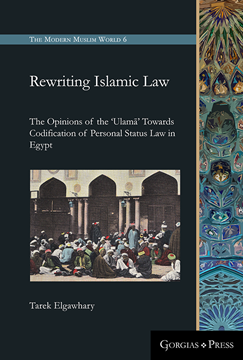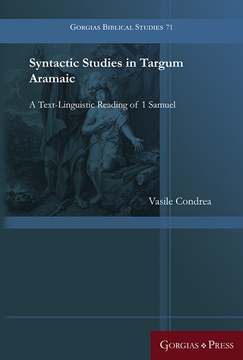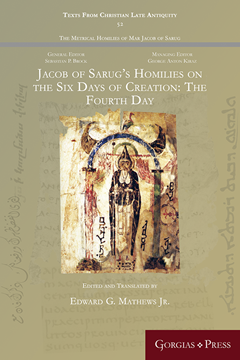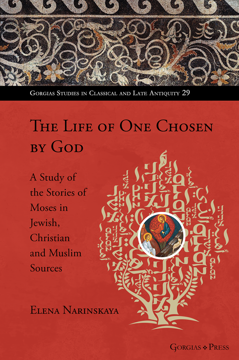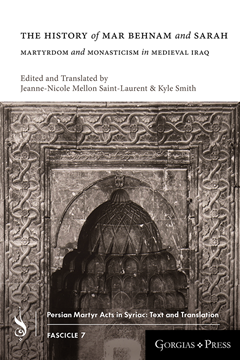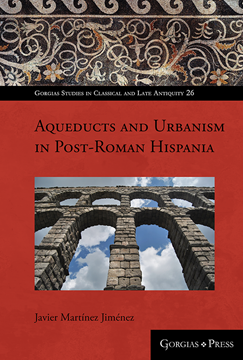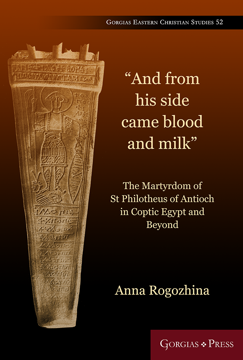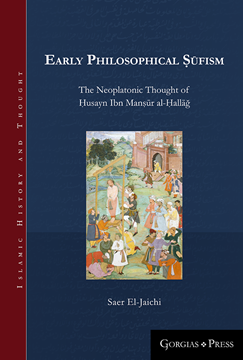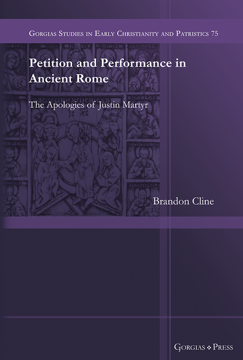Hugoye - Journal of Syriac Studies (volume 20)
2017
General Editor George Anton Kiraz
Series: Hugoye: Journal of Syriac Studies 20
ISBN: 978-1-4632-3906-0
Widely regarded as a premier journal dedicated to the study of Syriac, Hugoye: Journal of Syriac Studies was established in 1998 as a venue devoted exclusively to the discipline. An organ of Beth Mardutho, the Syriac Institute, the journal appears semi-annually and will be printed in annual editions. A peer-reviewed journal, Hugoye is a respected academic source for up-to-date information about the state of Syriac studies and for discovering what is going on in the field. Contributors include some of the most respected names in the world of Syriac today.
$75.00 (USD) $45.00 (USD)
Rewriting Islamic Law
The Opinions of the 'Ulamā' Towards Codification of Personal Status Law in Egypt
Series: Gorgias's Modern Muslim World 6
ISBN: 978-1-4632-3908-4
This book explores the process, effects, and results of codification of Egyptian personal status laws as seen through the eyes of the ‘ulamā’. The codification process began in the mid-1800s and continued until the abolishment of the Sharī‘a courts in 1955 with the absorption of personal status statutes into the newly drafted civil code and the national courts that administered them.
$114.95 (USD) $68.97 (USD)
Syntactic Studies in Targum Aramaic
A Text-Linguistic Reading of 1 Samuel
Series: Gorgias Biblical Studies 71
ISBN: 978-1-4632-3910-7
How can one distinguish between narrative, which records a sequence of events, and a narrator's comment on these events, in the form of notes, clarifications, and retellings? Syntax of Targumic Aramaic: A Text-Linguistic Reading of 1 Samuel applies the insights of Functional Sentence Perspective and Text Linguistics to Targum 1 Samuel. Through this analysis, Condrea answers key questions about Aramaic syntax and recovers the voice and contributions of the text's narrator.
$164.00 (USD) $98.40 (USD)
Jacob of Sarug’s Homilies on the Six Days of Creation (The Fourth Day)
The Fourth Day
Edited and Translated by Edward G Mathews Jr
Series: Texts from Christian Late Antiquity 52
ISBN: 978-1-4632-3912-1
In this fourth installment of the long Homily 71, On the Six Days of Creation, Jacob treats of the events of the fourth day, the creation of the spheres of light over the earth: the sun to rule over the day, and the moon and the stars to rule over the night.
$38.50 (USD) $23.10 (USD)
The Life of One Chosen by God
A Study of the Stories of Moses in Jewish, Christian and Muslim Sources
ISBN: 978-1-4632-3913-8
Moses is an inspirational prophetic figure in Jewish, Christian and Muslim religious traditions. This book journeys through the Abrahamic faiths and illustrates their respective depictions of the Moses’ stories. In exploring the differences and similarities between the Hebrew Bible, Jewish rabbinical commentaries, Syriac Christian exegesis and the Qur’an, this book seeks for a deeper understanding of the Prophet Moses in the religious history of humanity.
$155.00 (USD) $93.00 (USD)
The History of Mar Behnam and Sarah
Martyrdom and Monasticism in Medieval Iraq
Edited and Translated by Jeanne-Nicole Mellon Saint-Laurent & Kyle Smith
ISBN: 978-1-4632-3914-5
The History of Mar Behnam and Sarah tells the story of two siblings who convert to Christianity under the tutelage of Mar Mattai, a monastic leader and wonderworker from the Roman Empire. In this volume, Jeanne-Nicole Mellon Saint-Laurent and Kyle Smith provide the first critical edition and English translation of this fascinating martyrdom narrative.
$69.00 (USD) $41.40 (USD)
Aqueducts and Urbanism in Post-Roman Hispania
ISBN: 978-1-4632-3915-2
Our current knowledge of Roman aqueducts across the Empire is patchy and uneven. Even if the development of “aqueduct studies” (where engineering, archaeology, architecture, hydraulics, and other disciplines converge) in recent years has improved this situation, one of the aspects which has been generally left aside is the chronology of their late antique phases and of their abandonment. In the Iberian peninsula, there is to date, no general overview of the Roman aqueducts, and all the available information is distributed across various publications, which as expected, hardly mention the late phases. This publication tackles this issue by analysing and reassessing the available evidence for the late phases of the Hispanic aqueducts by looking at a wide range of sources of information, many times derived from the recent interest shown by archaeologists and researchers on late antique urbanism.
$114.95 (USD) $68.97 (USD)
"And from his side came blood and milk"
The Martyrdom of St Philotheus of Antioch in Coptic Egypt and Beyond
Series: Gorgias Eastern Christian Studies 52
ISBN: 978-1-4632-3916-9
This book examines the function and development of the cult of saints in Coptic Egypt, focusing primarily on the material provided by the texts forming the Coptic hagiographical tradition of the early Christian martyr Philotheus of Antioch, and more specifically, the Martyrdom of St Philotheus of Antioch (Pierpont Morgan M583). This Martyrdom is a reflection of a once flourishing cult which is attested in Egypt by rich textual and material evidence. This text enjoyed great popularity not only in Egypt, but also in other countries of the Christian East, since his dossier includes texts in Coptic, Georgian, Ethiopic, and Arabic.
$114.95 (USD) $68.97 (USD)
Early Philosophical Ṣūfism
The Neoplatonic Thought of Ḥusayn Ibn Manṣūr al-Ḥallāğ
Series: Islamic History and Thought 8
ISBN: 978-1-4632-3917-6
This study challenges the conventional image of the tenth-century Sufi mystic Al-Husayn Ibn Manṣūr al-Ḥallāğ (d. 929) as an anti-philosophical mystic. Unlike the predominantly theological or text-historical studies which constitute much of the scholarly literature on Ḥallāğ, this study is completely philosophical in nature, placing Ḥallāğ within the tradition of Graeco-Arabic philosophy and emphasizing, in a positive light, his continuity with the pagan Neoplatonism of Plotinus and Proclus.
$141.00 (USD) $84.60 (USD)
Petition and Performance in Ancient Rome
The Apologies of Justin Martyr
ISBN: 978-1-4632-3918-3
The system of petition and response was part and parcel of life in the Roman Empire. This book contextualizes Justin Martyr’s Apologies within this system of petition and response, arguing that Justin, in a fertile moment in the history of administrative practice, took a well-scripted form of imperial supplication and public display and boldly transformed it into a uniquely stylized statement of voiced injustice and Christian transparency. Using the heuristic of performance, this book not only compares the Apologies to extant petitions but draws attention to Justin’s strategies of elaboration and to the qualities of his work as a staged enactment within wider political, social, and literary contexts. The result is a reading of the Apologies as an opportunistic combination of petitionary, apologetic, and protreptic discourses by which Justin sought to address both his procedural objections to Christian trials and the popular and philosophical prejudices of his learned contemporaries.
$114.95 (USD) $68.97 (USD)

